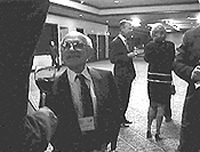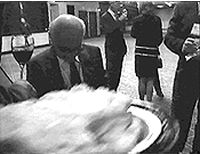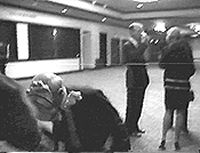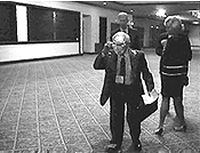NEOLIBERALISM
THE NEW GLOBAL ECONOMIC ORDER
The world is now witnessing an ongoing cycle of public protest and police repression in the US that is unprecedented since the world upheaval of 1968. From Seattle, where protestors shut down the talks of the World Trade Organization in December, to Washington DC, when authorities recently had to go to super-extraordinary lengths to prevent a shutdown of the World Bank and International Monetary Fund annual meetings, unrest is in the air. The normally-docile populations of the West appear to be rising en masse, in protests that have brought together a broad coalition of labor unions, environmental activists, students, and non-governmental organization into a powerful resistance movement. But what is it about the global economy that has led to such insurrection?
Although many systemic aspects of the global economy of today were put in place 50 years ago, the philosophical assumptions about the role of the economy in society have changed completely. Coming after the New Deal, the Bretton Woods institutions sought to provide a welfare-state model of government. The suggestion that the market be allowed to drive social, political and environmental agendas was seen by most economists as potentially destructive. For example, in 1944, Karl Polanyi held that: "To allow the market mechanism to be sole director of the fate of human beings and their natural environment...would result in the demolition of society."
Today, economic policy is driven by what is known as "neo-liberalism," which reverses the welfare state model and makes everything subservient to an absolutely free market – free of government regulation, labor unions, social welfare, environmental laws and ethical imperatives – as the best way to secure human prosperity, health and happiness. Developed in the 1960s by a minority cadre of conservative economists led by Milton Friedman, and driven by a wealthy network of foundations, institutes, research centers and publishers, the doctrine of neo-liberalism has emerged as the dominant paradigm, and the ideological fuel of the global economy.

Margaret Thatcher and Ronald Reagan gave neo-liberalism a big boost in the 1980s. By then, many economists treated it as an unquestionable and inevitable truth – rather than as a vested economic construct – enabling Thatcher and Reagan to lead the neo-liberal ‘revolution’ with their rallying cries of "competition" and "efficiency." Allowing these mantras to shape all decisions regarding economic, political and social policy, and driven by a strict social Darwinism, neo-liberalists reshaped the face of the world economy in less than a decade. But while competition and efficiency govern life at the lowest levels of society and economy, transnational corporations still reign virtually unhindered in an almost monopolistic alliance.
In a world driven by neo-liberalism, privatization is supposedly the answer to all problems. Privatization began in earnest in Britain under Thatcher, but soon spread to the US under Reagan. In the neo-liberal worldview, anything that has not been privatized is inefficient, and this informs the drive to privatize the public sectors, including things like health care, schooling, welfare and social security. But in order to privatize some public sector services, such as railroads, power grids and waterworks, neo-liberalists are hijacking systems that were constructed and maintained under a welfare state model.

The privatization of large public sector industries ended up handing them to wealthy institutions such as banks and investment firms. In Britain, for example, employees were only able to purchase a paltry 1-2 percent of previously publicly-held shares when Thatcher privatized the telecommunications, aviation and aerospace industries. Public services are now run for the benefit of greedy investors lining their own pockets while public services crumble and fall into disrepair.
In the US, income distribution shifted radically in favor of the wealthy under Reagan’s neo-liberalist policies. During the 1980s, the wealthiest 10 percent of American families increased their income by nearly 20 percent, while the top 5 percent took home a staggering 25-30 percent more. Meanwhile, the other 90 percent of Americans lost considerable income, with the bottom 10 percent losing over 15 percent of their already paltry earnings. While the income of the wealthy 10 percent increased from $200,000 to $400,000 per year under ‘Reaganomics’, the income of the bottom 10 percent fell from $4,000 to $3,500. American corporate executives began to take home astronomical salaries, up to 200 times higher than those of their average workers, who often struggled to keep their jobs in the face of massive layoffs and cutbacks.

Neo-liberalism benefits the wealthiest 10-20 percent of most societies, which explains why it is the preferred mode of discourse of the media and politics, which are dominated by the wealthy the world over. Proving that ideas do have real effects in the world – contrary to Marxian thought – neo-liberalists launched and maintained what amounts to a major campaign of thought-control to ensure that citizen-consumers of the world do not see its destructive flaws and that they are unable to conceptualize any other possibilities, or even that neo-liberalism is anything but an inevitable, eternal truth of economic thought. However, as the top 20 of society gets richer, the rest lose even basic benefits and – to the extent that the propaganda does not work – lose confidence in the system, which in part explains the recent protests.
In the global economy, neo-liberalists have insisted on a definition of free market capitalism that is characterized by three interlocking features: freedom of trade, freedom of capital and freedom of investment. The keystone of these efforts was the creation of the World Trade Organization in 1995, which came about after meticulous negotiations in the halls of power, largely out of sight of most citizen-consumers. However, the neo-liberal megamachine is not completely up and running, and negotiations are still ongoing. It is during this crucial formative period that neoliberalism is most liable to be challenged by public protests.
